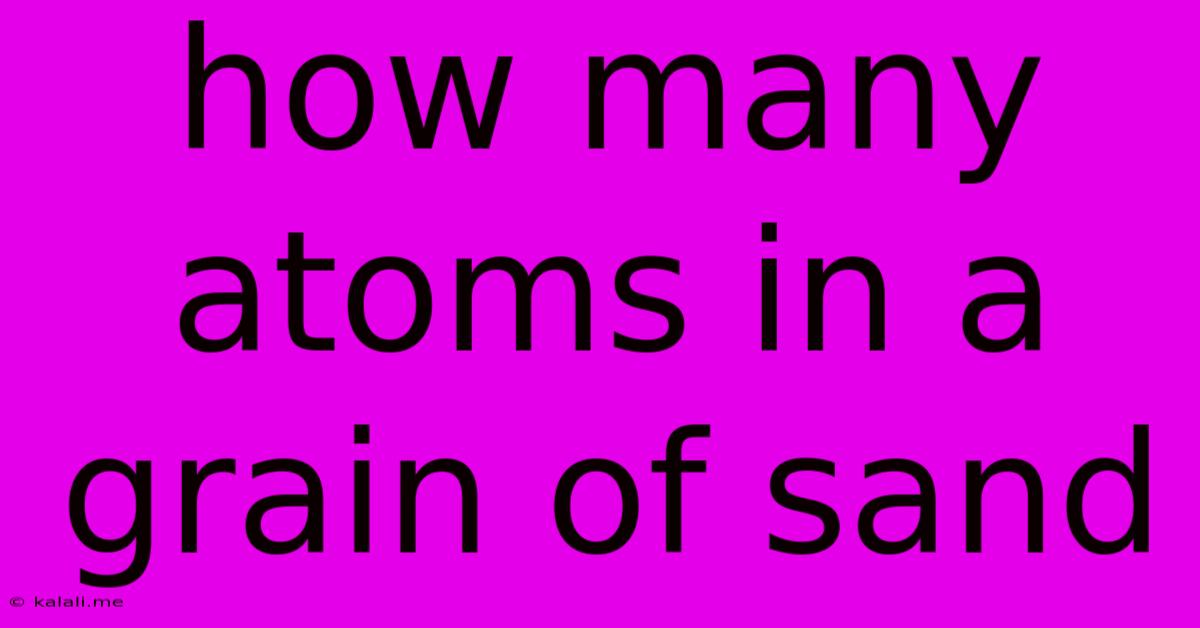How Many Atoms In A Grain Of Sand
Kalali
May 19, 2025 · 3 min read

Table of Contents
How Many Atoms in a Grain of Sand? A Deep Dive into the Microscopic World
Have you ever held a grain of sand and wondered about its composition? It seems insignificant, yet it holds a universe of atoms. This article explores the fascinating question: how many atoms are in a single grain of sand? We'll delve into the science behind the calculation and uncover the staggering numbers involved.
A seemingly simple question reveals a surprisingly complex answer, requiring an understanding of chemistry, physics, and some clever estimations. The number isn't fixed; it varies depending on the size and mineral composition of the grain. However, we can arrive at a reasonable approximation.
Understanding the Components: Silicon and Oxygen
Sand is primarily composed of silicon dioxide (SiO₂), also known as silica. This compound is made up of silicon atoms and oxygen atoms bonded together. To estimate the number of atoms, we need to know:
-
The average size of a grain of sand: Sand grains vary greatly in size, typically ranging from 0.0625 mm to 2 mm in diameter. For our calculation, let's assume an average diameter of 1 mm. This translates to a spherical volume.
-
The density of silica: Silica has a density of approximately 2.65 g/cm³. This tells us the mass of silica contained within a given volume.
-
Avogadro's number: This fundamental constant in chemistry is approximately 6.022 x 10²³ atoms/mol. It represents the number of atoms or molecules in one mole of a substance.
-
The molar mass of silica (SiO₂): This is the mass of one mole of SiO₂, which is approximately 60.08 g/mol. This allows us to convert mass to the number of moles.
The Calculation: A Step-by-Step Approach
-
Calculate the volume of the sand grain: Assuming a spherical grain with a 1 mm diameter (0.5 mm radius), the volume is (4/3)πr³ ≈ 0.524 mm³. Converting this to cubic centimeters, we get 0.000524 cm³.
-
Calculate the mass of the sand grain: Using the density of silica, we can find the mass: 0.000524 cm³ * 2.65 g/cm³ ≈ 0.00139 g.
-
Convert mass to moles: Using the molar mass of silica, we can find the number of moles: 0.00139 g / 60.08 g/mol ≈ 2.31 x 10⁻⁵ mol.
-
Calculate the number of SiO₂ molecules: Multiply the number of moles by Avogadro's number: 2.31 x 10⁻⁵ mol * 6.022 x 10²³ molecules/mol ≈ 1.39 x 10¹⁹ molecules.
-
Calculate the total number of atoms: Each SiO₂ molecule contains 3 atoms (1 silicon and 2 oxygen). Therefore, the total number of atoms is approximately 1.39 x 10¹⁹ molecules * 3 atoms/molecule ≈ 4.17 x 10¹⁹ atoms.
Conclusion: Mind-Boggling Numbers
This calculation shows that a single, seemingly insignificant grain of sand contains an astonishing number of atoms—on the order of 4.17 x 10¹⁹. This number highlights the incredibly small scale of atoms and the vastness of the microscopic world contained within everyday objects. Remember, this is just an approximation, and the actual number can vary based on the grain's size and precise composition. However, it gives us a powerful illustration of the sheer scale of matter at the atomic level. Exploring this further could lead to investigations into different types of sand and their elemental compositions. The possibilities for scientific inquiry are vast!
Latest Posts
Latest Posts
-
Do Washing Machines Use Hot Water
May 19, 2025
-
Which Battery Terminal To Connect First
May 19, 2025
-
Can You Drink Tap Water In Greece
May 19, 2025
-
Looking Forward To Hear From You Or Hearing
May 19, 2025
-
What Is The Difference Between The
May 19, 2025
Related Post
Thank you for visiting our website which covers about How Many Atoms In A Grain Of Sand . We hope the information provided has been useful to you. Feel free to contact us if you have any questions or need further assistance. See you next time and don't miss to bookmark.